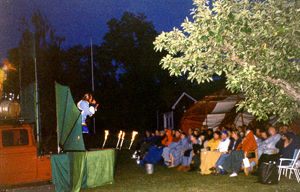Traditionally a Commedia dell’Arte stage was used to be a banco, made of wood, about two meters tall and not much bigger than a horse driven cart, about 3 x 4 meters. It usually had a simple backdrop and where very easy to transport, but it could also be much more elaborated with walls and a roof over the stage.
The backdrops had usually two or three entrances representing the doors of the vecchi’s houses, wish where painted on it. It made the stage depicting a city square. The houses usually had painted window that could open so the actors could talk from within the houses.
Nowadays most stages have just a bright colored backdrop with entrances so that it easier can be seen from across a big plaza. Since there is nothing painted on it the plot can always be anywhere or nowhere. As Commedia dell’Arte nowadays is for the most part representing archetypes of our inner life (See HERE) it seems more adequate.
The two or three entrances still have to be there for the mask’s entries and exits. Whether we use a blank or painted backdrop the stage is always bare, allowing the actors to use their skills to give energy and play to the stage and let them be the visual focus.
To keep the stage for Commedia dell’Arte small is beneficial first of all to keep up tempo. Distances on stage have a tendency to take time. On a small stage there is only one step to move from one place to another, representing a much greater distance. So for a mask to move fast or run it is a question of how many steps the mask takes per second rather than how much space each step covers.
Since the stage is so small and the actor have obviously very little space to move in, there are several conventions making the audience agree the actors are in different places or distances from each other on stage (and also to be able to act two and two). I have written more about STAGE STRATEGIES here.
The shallow stage also helps the actors in their entries and exits. Not only because of the timing and short distances, but it also helps the mask in their constant contact with the audience or when leaving the stage by not having to turn their backs to the audience in order to look for the exit.
 Then there is naturally different ways when raising the stage OUTDOORS or INDOORS.
Then there is naturally different ways when raising the stage OUTDOORS or INDOORS.
Other related posts about Commedia dell’Arte is:
The content in Commedia dell’Arte
The roots to all popular western comedy
Commedia dell’Arte lecture


Pingback: The scenario in Commedia dell’Arte (Part 2) |
Pingback: Stage strategies (Part 2) |
Pingback: Stage strategies (Part 1) |